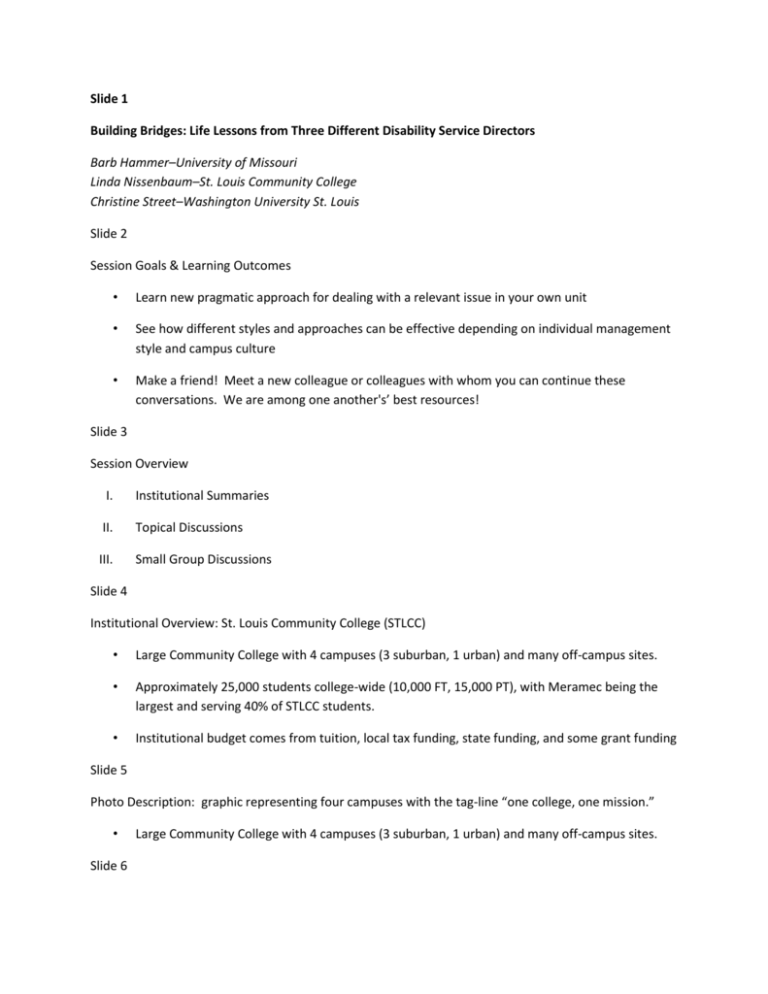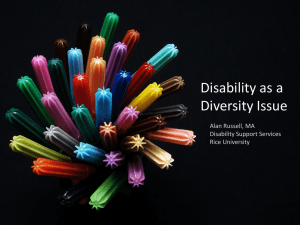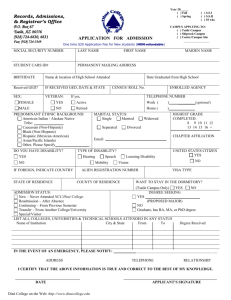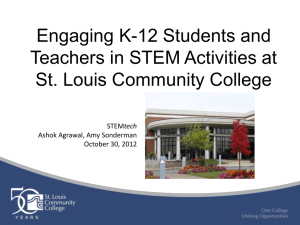1.4 Building Bridges Text Outline
advertisement

Slide 1 Building Bridges: Life Lessons from Three Different Disability Service Directors Barb Hammer–University of Missouri Linda Nissenbaum–St. Louis Community College Christine Street–Washington University St. Louis Slide 2 Session Goals & Learning Outcomes • Learn new pragmatic approach for dealing with a relevant issue in your own unit • See how different styles and approaches can be effective depending on individual management style and campus culture • Make a friend! Meet a new colleague or colleagues with whom you can continue these conversations. We are among one another's’ best resources! Slide 3 Session Overview I. Institutional Summaries II. Topical Discussions III. Small Group Discussions Slide 4 Institutional Overview: St. Louis Community College (STLCC) • Large Community College with 4 campuses (3 suburban, 1 urban) and many off-campus sites. • Approximately 25,000 students college-wide (10,000 FT, 15,000 PT), with Meramec being the largest and serving 40% of STLCC students. • Institutional budget comes from tuition, local tax funding, state funding, and some grant funding Slide 5 Photo Description: graphic representing four campuses with the tag-line “one college, one mission.” • Slide 6 Large Community College with 4 campuses (3 suburban, 1 urban) and many off-campus sites. Photo Description: four images representing the campuses for STLCC Florissant Valley, STLCC Forest Park, STLCC Meramec, STLCC Wildwood The 4 STLCC Access Offices have a long history of working together with consistent policies and procedures Slide 7 Photo Description: Graphic showing an overhead view of the campus of St. Louis Community College Meramec. Meramec is the largest campus serving 40% of STLCC students. The majority of the students at this campus are seeking a transfer degree to a four year college or university Slide 8 Photo description: picture of hallway in St. Louis Community College Meramec building with directional sign overhead that reads “Access Office, TRIO Office, VPSA Office” Meramec’s Access Office is housed in the Administration Building along with the VPSA Office, TRIO, Administration and Registration, Financial Aid, Advising and Counseling, the President’s Office and Community Relations. Slide 9 Photo Description: photo of entrance into an office, with the door partially ajar The Meramec Campus has four FT professionals, two FT classified, and one PT classified position for the Meramec Access Office. Additionally, the Adaptive Technology Specialist and a PT captioner report to the Director of Library Services, and the Assessment Center has additionally staff that provide over 1500 hours per semester of out-of-class testing. Slide 10 Graphic included on slide that reads: Access Office, disAbility Support Services. Approximately 553 registered students with disabilities registered with the Meramec Access Office and 1200 students with disabilities registered college-wide. Disabilities served include: LD 28%, Psych 12%, Ortho 2%, Health 5%, Vision 3%, Deaf/HOH 3%, ABI 1%, BIF .01%, ADHD 16%, LI 4%, Undetermined 15%, Autism-Spectrum 9% Slide 11 Photo description: picture of hallway in St. Louis Community College Meramec building with directional sign overhead that reads “Access Office, TRIO Office, VPSA Office” The Meramec Access Office is a decentralized program. While services are compliance-based, they also include, advising, academic coaching, coordination of out-of-class testing through the Assessment Center, relationships with the Information Access Lab/Library, and Academic Support Programs that help us to provide paid notetakers and other assistance. Slide 12 Photo Description: Overhead photo of the University of Missouri campus with Jesse Hall in the center of the picture Institutional Overview: University of Missouri Slide 13 Photo Description: photo of Memorial Union tower on University of Missouri campus, with maple trees with fall color flanking the sidewalk Large, publicly funded research based institution (member of AAU) More than 34,000 students (approx. 27,000 undergraduate) Slide 14: Over 306 degree programs through 19 colleges; largest research operation of any public university in Missouri; only one of six public universities nationwide with schools of medicine, veterinary medicine and law on one campus More than 30 percent of MU students come from another state or country Slide 15 Graphic included on slide that reads: Disability Center, University of Missouri, Promoting Access and Inclusion The Disability Center is part of the Division of Student Affairs, which also has Student Life, the Counseling Center, Residential Life, Campus Dining, Student Auxiliary Services, Mizzou Rec Services, and as of July 1, Student Health Slide 16 Eight full time staff: two administrative support staff, four Access Advisors (one who is a Deaf Services Coordinator), an Exam Coordinator and the Director. Over 1100 students registered during 2012 – 2013 academic year (40% cognitive, 1% developmental, 10% health related, 2% deaf/hard of hearing, 16% learning, 4% physical, 17% psychological, 3% blind/low vision, 6% temporary conditions, and less than 1% neurological and speech/language) Slide 17 Photo description: photo of door at entrance of the Disability Center at MU. Disability Center services are primarily compliance based. Additional supports include a Graduate Assistant within the Disability Center who provides one-on-one counseling with clinical supervision provided by Counseling Center psychologist, and one-on-one tutoring through the Learning Center (funded in part by TRIO and in part by the campus). Slide 18 The Disability Center works collaboratively with the Adaptive Computing Technology Center at MU to provide alternative formats. ACT (part of IT) manages the physical conversion of materials, provides software/hardware support for students, and hosts server space for e-texts. Exam accommodations and all other accommodations are provided by the Disability Center. In 20122013, the Disability Center scheduled 6162 exams, and administered 4768 exams. Slide 19 Photo Description: A photograph of the main entrance of the campus at Brookings Hall Institutional Overview: Washington University in St. Louis Slide 20 Five undergraduate schools (A&S, business, art, architecture, and engineering) and 7 graduate schools (A&S, law, medicine, business, art & architecture, engineering, and social work) Medium-size, highly selective research institution with strong “known by name and story” culture Slide 21 Graphic of Washington University in St. Louis logo Approx. 7000 undergraduate students and 6000 graduate students In addition to tuition, research funds, direct clinical care, and endowment revenues provide significant portion of institutional budget Slide 22 Photo description: Photo of façade of Gregg House, where the Disability Resources office is located on the campus of Washington University Disability Resources: Housed within Cornerstone Center for Advanced Learning, along with Academic Support Programs and Trio Support Programs Services are primarily compliance-based; however, co-location results in more intensive and targeted academic supports Three FTEs for Disability Resources alone, although other Cornerstone staff also support mission Slide 23 DR staff includes assistant director for disability resources and two masters-level disability resources coordinators. Approximately 700 registered students with disabilities (54% LD and/or ADHD, 26% mental health, 20% chronic health, 5% mobility, 4% food allergies, 4% hearing/vision, 1% ASD) Unit manages the provision of all accommodations, including testing. In 2013-2014, DR oversaw 4728 exams Slides 24 through 35 contain the same information with a different topical word in bold text to demonstrate which topic the speakers are discussing Topical Issue Discussions Personnel Staffing Budget Collaborating across campus Workflow/Work Assignments Data Collection & Reporting Use of Technology for Office Management Adaptive Technology Strategic Planning Leadership Campus Education & Training Slide 35 Small Group Discussion • Break down into small groups and select a “group reporter or reporters” • As a group, select 3 or 4 issue prompts that pertain to areas that your group finds particularly challenging or interesting • Discuss the prompts, with the reporter(s) taking enough notes to be able to report out to the larger group • Be sure to exchange names and contact information for future conversations. Slide 36 Any Questions?






